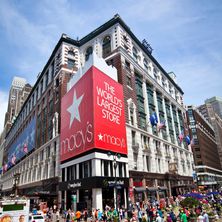

Until 2009, when it was surpassed by a Korean store, the Macy's Flagship Store on Herald Square was, according to the Guinness Book of World Records, the largest department store in the world. It has a total of about 205,000 square meters of retail space. The saddest thing, however, is that the founder of the department store chain, Rowland Hussey Macy, did not live to see the construction of this behemoth. He died in 1877, twenty-four years before the building was erected.
R. H. Macy was born in 1822, in Massachusetts. When he was a teenager working on a whaling ship he had a red star tattooed on his hand. This red star later became the logo that the Macy's department stores would use. After realizing that his dry goods stores in Massachusetts were not bringing him success, at the age of thirty-six Macy moved to New York to try his luck there. He opened his first Macy's on the corner of Sixth Avenue and 14th Street. Business picked up quickly and soon he was running several stores throughout the city. In 1875 Macy brought in two partners, whose investments and knowhow helped sales skyrocket. Unfortunately, Macy died two years later in Paris and his company was left in the hands of his partners. However, by 1879 both of them had also passed away and Macy's family became the sole owner. Several years later the family sold most of its shares to brothers Isidor and Nathan Straus, the founders of the Abraham & Straus department store.
Currently Macy's, Inc. has 838 locations nationwide and employs about 176,000 people. Its revenues in 2014 were almost $30 billion. Its products include clothing, footwear, bedding, accessories, furniture, jewelry, housewares and beauty products. Other important flagship stores, besides the most famous one on Herald Square, are located in San Francisco and Los Angeles.
The flagship store on Herald Square was built in 1901 by German-American architect Theodore de Lemos. It ran from Broadway to about the midway point on 34th Street. Later in the 20th century, in order to expand its enterprise, Macy's bought the other buildings on 34th Street, some of whom were its competitors, and incorporated them into one single compound. Today the Macy's building is indeed immense: it occupies the entire block between Broadway in the east, 7th Avenue in the west, 35th Street in the north and 34th Street in the south. It is the most sought-after department store in New York by middle-range customers. It is known for its creative window displays, especially during holidays, which can attract the attention of even the most unmaterialistic individual.
Macy's is also known for its Thanksgiving Day Parade, the second oldest Thanksgiving parade in America, which has taken place every year since 1928. It features enormous animal-shaped balloons, floats, world-famous dancers and singers, acrobats, marching bands, Disney characters, Marvel Comics characters and just about any other character that the American public can imagine. The routes have changed since the beginning, but the starting point has always been somewhere around Columbus Circle by Central Park and the destination was, as could be expected, Herald Square. The parade is one of the principal reasons why Macy's is so firmly ingrained in the New York consumer consciousness.